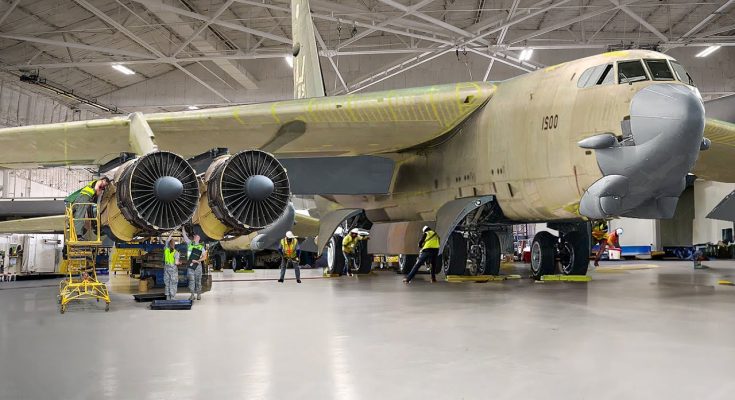The B-52 Stratofortress, one of the most iconic and enduring symbols of U.S. airpower, is a heavy strategic bomber that has been a vital component of the U.S. Air Force’s long-range strike capability since the 1950s. Central to the B-52’s formidable performance are its eight powerful engines, each weighing about 5,000 pounds. The responsibility for keeping these massive engines in top condition falls to a group of skilled U.S. Airmen who maintain them with precision and expertise.
The maintenance of a B-52’s engines is no simple task. These jet engines are not only massive but also complex, featuring high-tech components that require specialized training and knowledge. Airmen working in engine maintenance must be adept in handling these intricate systems, ensuring every part functions properly to support the B-52’s ability to carry out long-range missions, sometimes lasting for several hours or even days.
At the heart of this operation is the turbine engine itself, which provides the thrust necessary to propel the B-52 at high speeds across vast distances. These engines can reach speeds of over 600 miles per hour and fly at altitudes as high as 50,000 feet. They’re designed to endure extreme conditions, from high-speed flight to long periods of idling on the tarmac before takeoff.
One of the first steps in engine maintenance involves a thorough inspection. Airmen meticulously check for any signs of wear, damage, or stress on each engine component. Parts such as the compressors, turbines, and nozzles are examined for cracks, corrosion, or misalignment. Any problems found are addressed immediately, as even the smallest malfunction can affect the engine’s performance, potentially jeopardizing a mission.
The B-52’s engines are also subject to routine maintenance, including oil changes, cleaning, and recalibration of various sensors that monitor engine performance. The engines are built to be easily replaceable, but their weight and size mean that working on them requires careful planning and the use of specialized equipment. Crane systems, high-tech diagnostic tools, and other machinery are employed to lift and transport the engines for repair or replacement, often in a hangar specifically designed for this purpose.
Airmen also work to ensure that the engines meet the high standards of efficiency and fuel consumption, critical factors in any military aircraft. These engines are designed for longevity and reliability, with regular inspections and preventive maintenance contributing to their long lifespan. Ensuring that these engines continue to run smoothly and efficiently is crucial, as the B-52 is expected to remain operational for decades, even as it faces the challenges of modernizing the Air Force’s fleet.
This maintenance role plays a critical part in the continued success of the B-52 as a strategic asset. The aircraft is capable of carrying nuclear weapons, conventional bombs, and precision-guided munitions, making it a versatile platform for a range of military operations. The skill of the Airmen who maintain its engines is directly tied to the bomber’s ability to perform at the highest levels, delivering power and deterrence on the global stage.
In conclusion, maintaining the 5,000-pound engines of the B-52 bomber requires not only technical expertise but also an understanding of the aircraft’s critical role in national defense. The Airmen who take on this responsibility are essential to keeping one of the U.S. military’s most powerful weapons ready for action, ensuring the bomber continues to be a formidable force in the skies.



